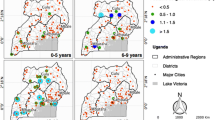Abstract
Purpose
While an estimated two billion people lack access to surgical care, little data are available on surgical conditions for pediatric populations in low- and middle-income countries. Our study aims to assess pediatric surgical needs in Nepal.
Methods
A countrywide cross-sectional study was performed in 15 randomly chosen districts; 3 clusters (2 rural; 1 urban) per district were selected. The prevalence of surgical conditions, unmet surgical needs, and barriers to care were analyzed among children (0–18 years of age).
Results
Overall, 1,350 households and 2,695 individuals were surveyed (response rate: 97 %); 800 respondents (29.7 %, 95 % CI 27.9–31.4 %) were pediatric; 59.8 % (95 % CI 56.3–63.2 %) were male; median age was 10 years (IQR 5–15). Of them, 84 (10.5 %, 95 % CI 8.5–12.8 %) had a surgical condition; 48 (6.0 %, 95 % CI 4.5–7.9 %) reported an unmet need for surgical care. Based on this, we estimate that 706,076 (95 % CI 529,557–929,666) children live with untreated surgical conditions. Barriers to care included limited availability of services (31.3 %), funds (22.9 %), time (4.2 %), and fear/mistrust of medical services (16.7 %).
Conclusion
Close to 700,000 children in Nepal are estimated to need surgical consultation. Programs to address this should be developed alongside efforts by policy makers and donors to rectify the lack of care, bolster limited funds, and strengthen healthcare systems.

Similar content being viewed by others
References
Contini S (2007) Surgery in developing countries: why and how to meet surgical needs worldwide. Acta Biomedica-Ateneo Parmense 78(1):4
Weiser TG, Regenbogen SE, Thompson KD, Haynes AB, Lipsitz SR, Berry WR et al (2008) An estimation of the global volume of surgery: a modelling strategy based on available data. The Lancet. 372(9633):139–144
Groen RS, Samai M, Stewart K-A, Cassidy LD, Kamara TB, Yambasu SE et al (2012) Untreated surgical conditions in Sierra Leone: a cluster randomised, cross-sectional, countrywide survey. Lancet 380(9847):1082–1087
Petroze RT, Groen RS, Niyonkuru F, Mallory M, Ntaganda E, Joharifard S et al (2013) Estimating operative disease prevalence in a low-income country: results of a nationwide population survey in Rwanda. Surgery 153(4):457–464
Ozgediz D, Hsia R, Weiser T, Gosselin R, Spiegel D, Bickler S et al (2009) Population health metrics for surgery: effective coverage of surgical services in low-income and middle-income countries. World J Surg 33(1):1–5
Groen RS, Samai M, Petroze RT, Kamara TB, Cassidy LD, Joharifard S et al (2013) Household survey in Sierra Leone reveals high prevalence of surgical conditions in children. World J Surg 37(6):1220–1226
Kushner AL, Kallon C, Kamara TB (2012) Free health care in Sierra Leone: the effect on pediatric surgery. J Pediatr Surg 47(3):628–629
Alhalaby E, Millar A (2012) Challenges of pediatric surgical practice in Africa. Semin Pediatr Surg 21:101–102
Wu VK, Poenaru D, Poley MJ (2013) Burden of surgical congenital anomalies in Kenya: a population-based study. J Trop Pediatr 59(3):195–202
Nations U (2013) Fact sheet. Goal 4: reduce child mortality 2013. Available from: http://www.un.org/millenniumgoals/childhealth.shtml
Bickler S, Rode H (2002) Surgical services for children in developing countries. Bull World Health Organ 80(10):829–835
Central Bureau of Statistics (2014) Statistical pocket book Nepal 2010. Available from http://cbs.gov.np/?page_id=1079#1
Malla D, Giri K, Karki C, Chaudhary P (2011) Achieving millennium development goals 4 and 5 in Nepal. BJOG Int J Obstet Gynaecol 118(s2):60–68
UNDP (2013) Human development report 2013, The rise of the South: human progress in a diverse world
Central Intelligence Agency (2014) The world factbook—Nepal. Available from https://www.cia.gov/library/publications/the-world-factbook/geos/np.html
Acharya LB, Cleland J (2000) Maternal and child health services in rural Nepal: does access or quality matter more? Health Policy Planning 15(2):223–229
Spiegel DA, Shrestha OP, Rajbhandary T, Bijukachhe B, Sitoula P, Banskota B et al (2010) Epidemiology of surgical admissions to a children’s disability hospital in Nepal. World J Surg 34(5):954–962
Surgeons OverSeas Assessment of Surgical Need (SOSAS) version 3.0. Available from: http://www.adamkushnermd.com/files/SOSAS_survey2.pdf
Walker IA, Obua AD, Mouton F, Ttendo S, Wilson IH (2010) Paediatric surgery and anaesthesia in south-western Uganda: a cross-sectional survey. Bull World Health Organ 88(12):897–906
Gupta S, Ranjit A, Shrestha R, Wong EG, Robinson WC, Shrestha S et al (2014) Surgical needs of Nepal: pilot study of population based survey in Pokhara, Nepal. World J Surg 38(12):3041–3046
Gupta S, Shrestha S, Ranjit A, Nagarajan N, Groen RS, Kushner AL, et al (2014) Surgical care in Nepal: conditions, preventable deaths, procedures, and validation of a countrywide survey
Nepal Go, Secretariat NPC, Statistics CBo, Kathmandu N (2012) National population and housing census 2011 (National Report)
Bank TW (2014) The World Bank: working for a world free of poverty. Available from: http://go.worldbank.org/I99TRS72B0
Strategic plan for human resources for health, 2003 to 2017. Available from: http://www.unfpa.org/sowmy/resources/docs/library/R095_MOHNepal_2003_StrategicPlanHRH.pdf
Dixit H, Marahatta S (2008) Medical education and training in Nepal: SWOT analysis. Kathmandu Univ Med J 6(3):412–420
Bhutta ZA, Chopra M, Axelson H, Berman P, Boerma T, Bryce J et al (2010) Countdown to 2015 decade report (2000–10): taking stock of maternal, newborn, and child survival. Lancet 375(9730):2032–2044
Chu K, Rosseel P, Gielis P, Ford N (2009) Surgical task shifting in sub-Saharan Africa. PLoS Med 6(5):e1000078
Warriner I, Wang D, Huong N, Thapa K, Tamang A, Shah I et al (2011) Can midlevel health-care providers administer early medical abortion as safely and effectively as doctors? A randomised controlled equivalence trial in Nepal. Lancet 377(9772):1155–1161
Acknowledgments
This study was financially supported by the Association for Academic Surgery Global Surgery Research Fellowship Award and Surgeons OverSeas
Conflict of interest
Authors have none to disclose.
Author information
Authors and Affiliations
Corresponding author
Rights and permissions
About this article
Cite this article
Nagarajan, N., Gupta, S., Shresthra, S. et al. Unmet surgical needs in children: a household survey in Nepal. Pediatr Surg Int 31, 389–395 (2015). https://doi.org/10.1007/s00383-015-3684-1
Accepted:
Published:
Issue Date:
DOI: https://doi.org/10.1007/s00383-015-3684-1




